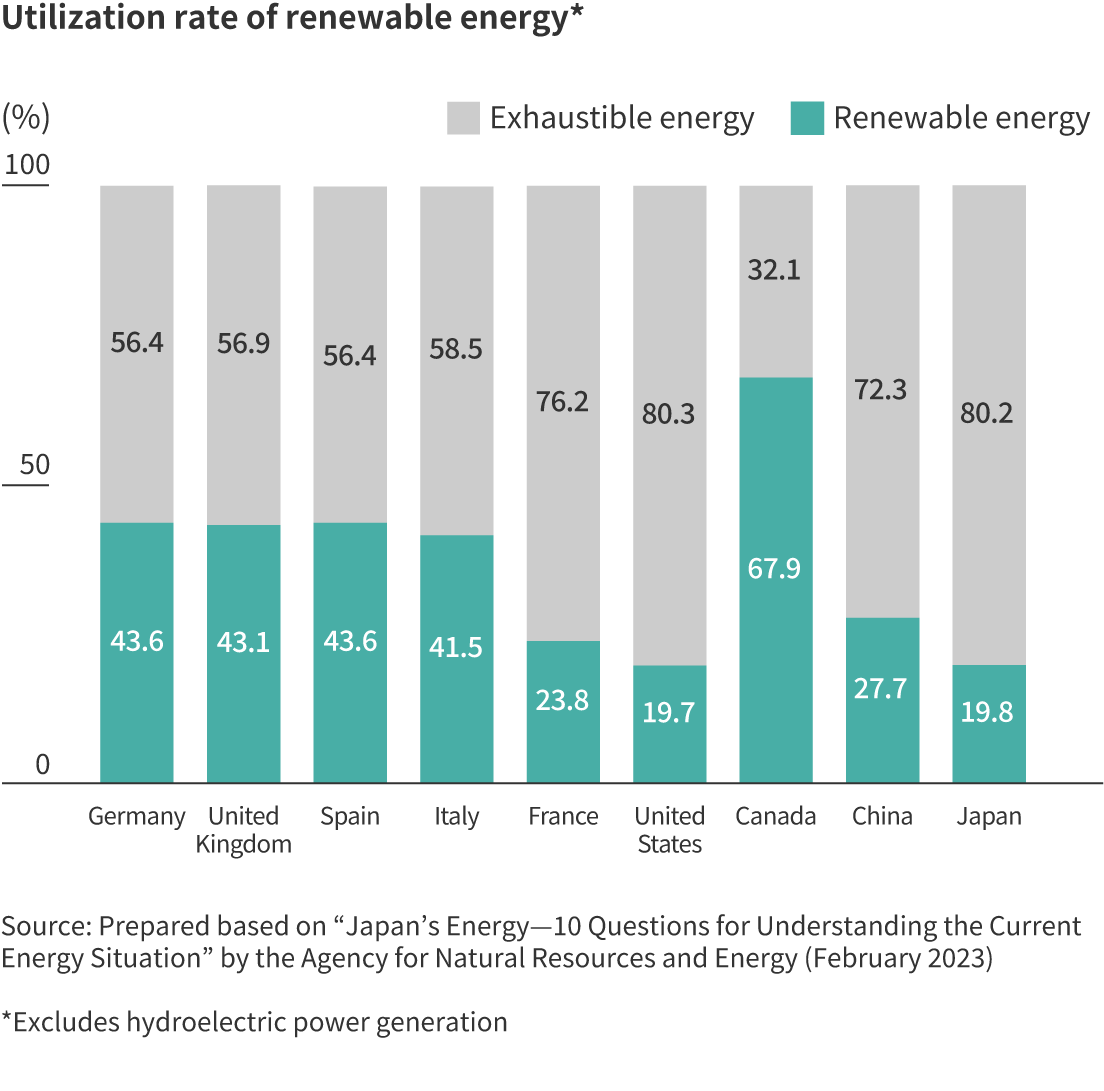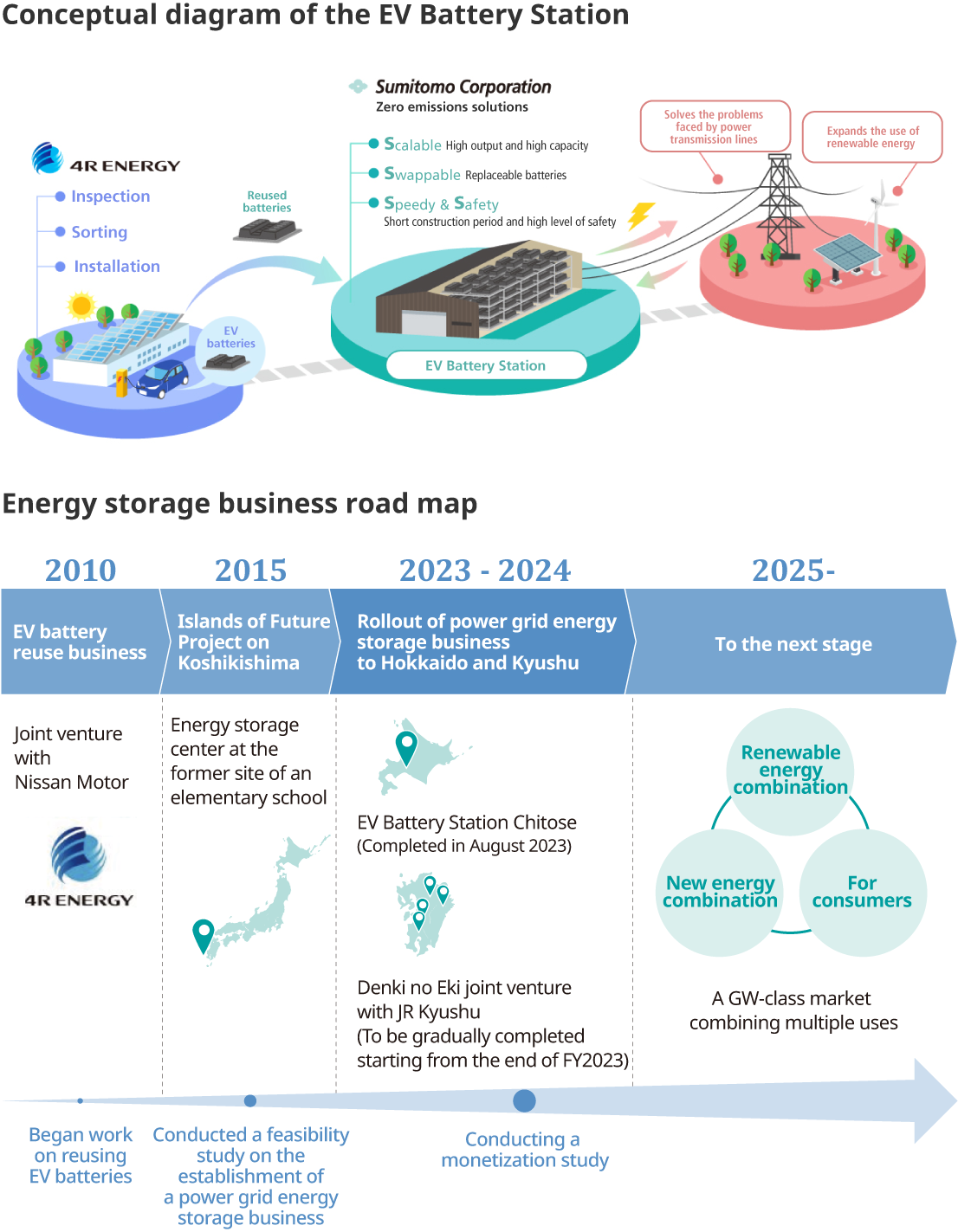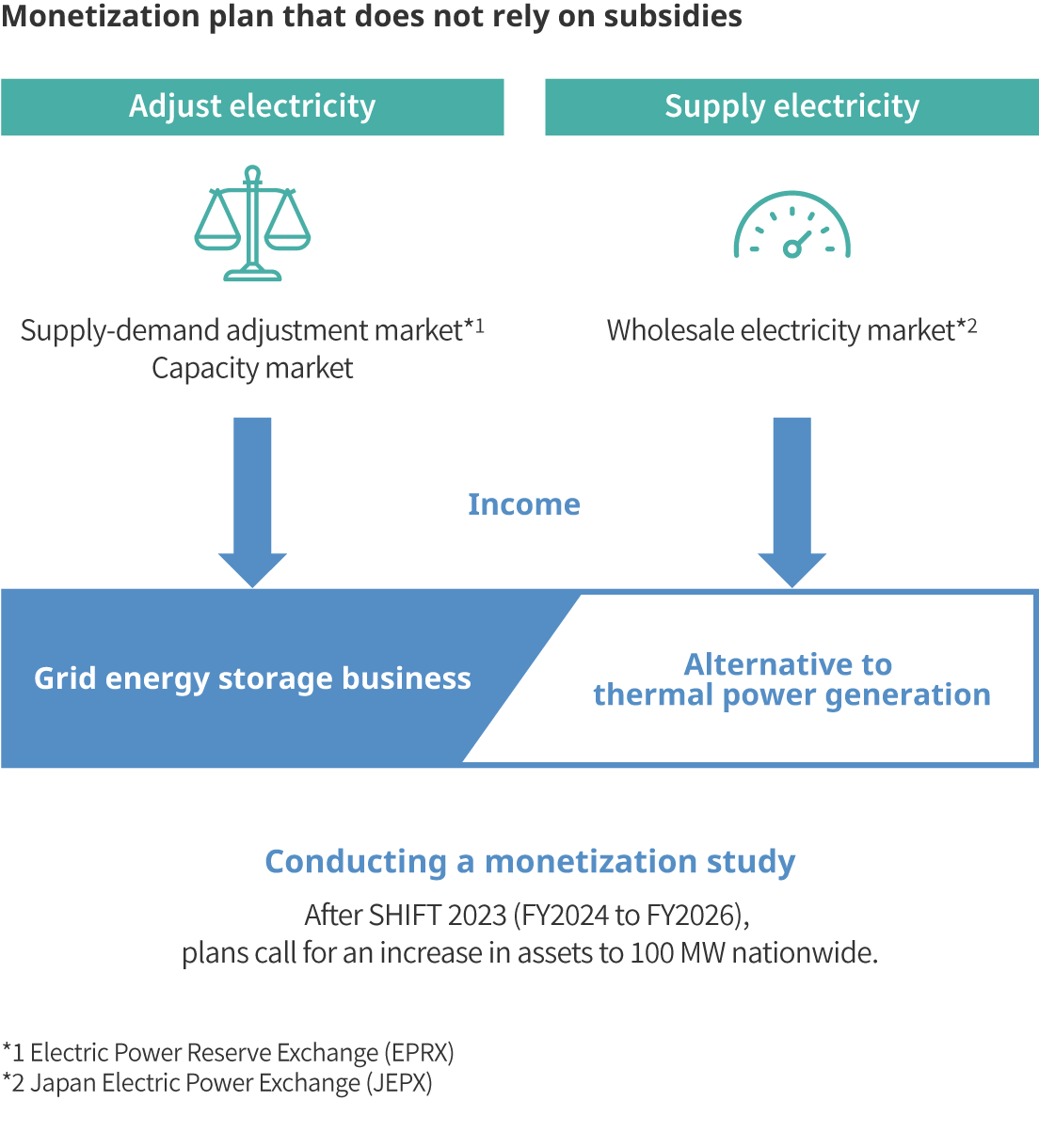Interview Key Social Issue | Mitigation of climate change
Large-scale energy storage business
Providing a platform that stores energy to promote the transition to renewable energy
The main challenge in promoting decarbonization is the transition to renewable energy, and its importance is indisputable. However, the introduction rate of renewable energy in Japan is still low compared to European and other countries. One of the main reasons is the insufficient capacity of transmission lines. In response to this issue, Sumitomo Corporation aims to expand its business of storing energy nationwide in Japan by developing a large-scale energy storage platform that can compensate for this lack of transmission line capacity. Here, we will delve into our path taken to launch a completely new business and start operation of the first large-scale energy storage facility in Japan in 2024, as well as the challenges and future prospects on the front line.
Interviewee

Satoshi Wada
Zero Emission Solution Business Department
Joined the Company in 2013. After being involved in the investment side of the Tubular Business Development Department of the Tubular Products Division (Metal Products Business Unit), he engaged in the trading of tubular products for automobile parts in the Mechanical Tubular Business Department in 2015. In 2018, he was seconded to the Sales Department of Nippon Steel Pipe America, Inc. in the United States. After returning to Japan in 2020, he was assigned to the Mechanical Tubular Business Department and moved to the Zero Emission Solution Business Department in 2021.
Why
Resolving issues facing the spread of renewable energy with large storage batteries
Despite the global trend toward decarbonization, the share of renewable energy in Japan remains at a low level of roughly 20%, as it is an unstable power source whose power generation is greatly affected by natural conditions, such as sunlight and wind, and because Japan's current power grid*1 is unable to accommodate this instability. In order for renewable energy providers to deliver electricity to users (households, factories, etc.), they must be connected to the power grid, but if the required amount of electricity exceeds the assumed amount, it may interfere with the stable supply of electricity. Therefore, even if a renewable energy provider plans to build or expand a solar power plant, there are cases where the power company that manages the power grid cannot accept the connection, which hinders the expansion of renewable energy.
As one of the solutions to this issue, there is growing interest in the energy storage business, which connects large storage batteries to the power grid and adjusts the surplus or deficiency of renewable energy power generation by charging and discharging these storage batteries.
*1 System integrating power generation and transmission of electricity companies. Managed by area; i.e., Tokyo Electric Power Company Holdings, Incorporated manages the Tokyo area.

What&How
Building a large storage battery system with reused batteries
Beginning more than a decade ago, Sumitomo Corporation was among the first to work on social implementation of large-scale storage batteries that can be connected to the power grid. In 2015, we started Japan's first demonstration project covering energy storage connected to the power grid in the Koshikishima, Satsumasendai City, Kagoshima. This project is still operating in a stable manner today.
One feature of our grid energy storage system is that it utilizes reused batteries from EVs. Although the penetration rate of EVs in Japan is still only about 1%, the Japanese government aims for 100% of all new passenger car sales to be EVs by 2035. This, at the same time, means that more batteries will be discarded. Focusing on this, Sumitomo Corporation envisioned a sustainable supply chain for an electrified and resource-saving society by reusing discarded batteries for large-scale energy storage.
Based on this concept, we have accumulated technical and operational know-how since the establishment of 4R Energy Corporation jointly with Nissan Motor Co., Ltd. in 2010 to reuse EV batteries, with the aim of commercializing large-scale energy storage systems that are more economical and have high output and capacity. After more than a decade of experiment, we developed the EV Battery Station, a large-scale energy storage system that combines hundreds of reused batteries to provide high output and capacity so that it can be connected to the power grid. In 2024, we plan to invest our accumulated know-how into the operation of the first large-scale energy storage plant in Japan, to be located in Chitose, Hokkaido.

Mr. Satoshi Wada at the energy storage facility of EV Battery Station Namie
Reducing CO2 by efficiently using EV batteries and renewable electricity
Our grid energy storage business contributes to decarbonization from two major perspectives.
First is the nationwide rollout of an energy storage platform. In response to the issue that renewable electricity cannot be used efficiently due to insufficient capacity in the power grid, we will develop a platform for storing energy using large storage batteries at the national level. By doing so, we will promote the use of renewable electricity, thereby contributing to CO2 reduction.
Second is the reuse of EV batteries. One EV battery is believed to emit approximately three tons of CO2 at the time of production. The reuse of batteries in the energy storage system means that new batteries no longer need to be manufactured, which not only reduces CO2 emissions by the same amount but also contributes to the life cycle assessment of EVs. In addition, 4R Energy is working to achieve zero CO2 emissions in the battery reuse process by installing solar panels and an energy storage system and utilizing solar power to avoid purchasing grid electricity.
Balancing CO2 reduction and economics to make the business sustainable
Although the capacity of the power grid needs to be increased in order to realize a sustainable society in which renewable electricity is mainstream, expanding transmission lines requires enormous time and cost. Therefore, we believe that infrastructure development using storage batteries presents a more realistic approach. To develop a sustainable storage battery infrastructure, it is essential to have a monetization mechanism in place without relying on subsidies. Our grid energy storage business has reached the stage where it can be profitable without subsidies. This was made possible thanks to our continuous efforts to reduce the cost of energy storage facilities and to the source of income provided by the rapidly evolving supply-demand adjustment market, capacity market, and wholesale electricity market. All of these factors contribute to the profitability of the business.
In these three markets, as it is important to predict trends in demand and price of electricity and charge and discharge electricity at the appropriate time, market forecasts are directly linked to income. Therefore, in parallel with the expansion of its energy storage facilities, we are also working to develop a program to maximize profits by forecasting the market.
To realize the transition to renewable energy, it is important to pursue economic efficiency and make it a sustainable business. We have been developing the business by installing energy storage facilities as a pioneer in the grid energy storage business. Based on this, as a trading company, in the future we aim to provide services such as market forecasting programs that are under development. While expanding our business area, we will also work to create a system that pursues greater economic efficiency and generate greater value.

Going forward
Launching businesses that contribute to the transition to renewable energy to leave prosperous lifestyles for the future
We still have a long way to go, but I think the main reason why we have made it this far is because we were allowed to conduct the demonstration experiments through trial and error. Just because the grid energy storage business was successful overseas, that did not mean it would be in Japan. Also, when it came to EV battery reuse, there were no success stories overseas. Furthermore, since this is a completely new business, there were frequent conflicts with existing rules. Because of this situation, we talked to various people, such as those from the relevant ministries, experts, and business partners, and put forward a hypothesis on the premise of receiving opposing views from them, which led to the demonstration experiments. The fact that we were able to spend money on the demonstration experiments and had a wide network is due to the scale of Sumitomo Corporation's business and the business foundation built by our predecessors.
I strongly believe that the transition to renewable energy should be accomplished in our generation, as it is absolutely necessary to leave prosperous lifestyles for society in the future. When I joined the Company, I gave myself the goal of creating a new company with a new business and then releasing what I had created to the world. I am extremely fortunate and honored to have been involved in this project at this time, with the introduction of the grid energy storage business that contributes to society's transition to renewable energy, building on the success of our predecessors. I will first make this business a success and get it on track, and then continue to create a new system that contributes to the resolution of social issues.

Interviews
- ../card/CO2-reduction-interview.html
- ../card/forest-interview.html
- ../card/bio-interview.html